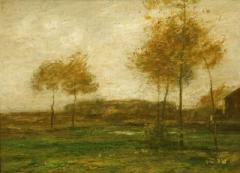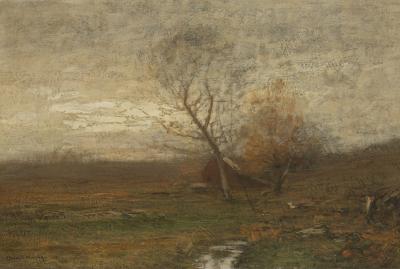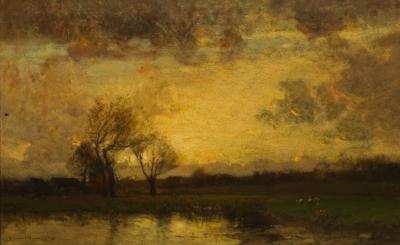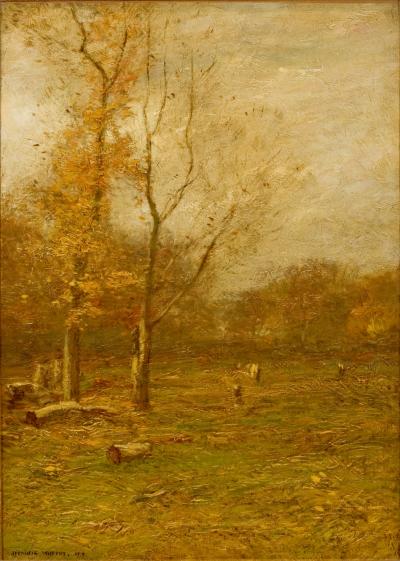John Francis Murphy
American, 1853 - 1921
Artist Bio: J. Francis Murphy (John Francis Murphy)
J. Francis Murphy, also known as John Francis Murphy, was a master Tonalist painter celebrated for his intimate landscapes that evoke deep emotional responses to nature. Born in Oswego, New York, in 1853, Murphy moved with his family to Chicago at the age of fifteen. Primarily self-taught, he began his artistic journey as a scene painter for the theater, honing his skills before transitioning to landscape painting.
In 1875, Murphy relocated to New York City, where he worked as an illustrator while embarking on sketching trips to the Adirondacks and Orange, New Jersey. His early works were characterized by crisp, descriptive imagery reminiscent of the Hudson River School, marked by a keen observation of nature. Over time, his style evolved into a more poetic expression, influenced by American artists such as Alexander Wyant and George Inness. He began to capture not just the visual but the emotive essence of his surroundings, utilizing a rich interplay of tone and texture.
Murphy's technique involved layering translucent glazes to create atmospheric effects, often depicting symbolic elements like bare trees and marshy landscapes. His breakthrough came after an inspiring trip to the Kenne Valley in the Adirondacks in 1874, where he sold many of his paintings to fund his travels. Settling in Arkville, New York, in the Catskills, he produced evocative scenes of meadows and still ponds, pushing his expressive style to new heights.
Murphy’s works garnered significant acclaim during his lifetime, earning recognition at prominent venues such as the Brooklyn Art Association and the Boston Art Club. His accolades included prizes from the National Academy of Design and various World's Fairs. Today, his paintings are part of prestigious collections, including the Metropolitan Museum of Art, the National Gallery of Art, and the Museum of Fine Arts, Boston.
J. Francis Murphy passed away in 1921, leaving behind a legacy as America's premier Tonalist, whose lyrical landscapes continue to resonate with art lovers and collectors.
J. Francis Murphy, also known as John Francis Murphy, was a master Tonalist painter celebrated for his intimate landscapes that evoke deep emotional responses to nature. Born in Oswego, New York, in 1853, Murphy moved with his family to Chicago at the age of fifteen. Primarily self-taught, he began his artistic journey as a scene painter for the theater, honing his skills before transitioning to landscape painting.
In 1875, Murphy relocated to New York City, where he worked as an illustrator while embarking on sketching trips to the Adirondacks and Orange, New Jersey. His early works were characterized by crisp, descriptive imagery reminiscent of the Hudson River School, marked by a keen observation of nature. Over time, his style evolved into a more poetic expression, influenced by American artists such as Alexander Wyant and George Inness. He began to capture not just the visual but the emotive essence of his surroundings, utilizing a rich interplay of tone and texture.
Murphy's technique involved layering translucent glazes to create atmospheric effects, often depicting symbolic elements like bare trees and marshy landscapes. His breakthrough came after an inspiring trip to the Kenne Valley in the Adirondacks in 1874, where he sold many of his paintings to fund his travels. Settling in Arkville, New York, in the Catskills, he produced evocative scenes of meadows and still ponds, pushing his expressive style to new heights.
Murphy’s works garnered significant acclaim during his lifetime, earning recognition at prominent venues such as the Brooklyn Art Association and the Boston Art Club. His accolades included prizes from the National Academy of Design and various World's Fairs. Today, his paintings are part of prestigious collections, including the Metropolitan Museum of Art, the National Gallery of Art, and the Museum of Fine Arts, Boston.
J. Francis Murphy passed away in 1921, leaving behind a legacy as America's premier Tonalist, whose lyrical landscapes continue to resonate with art lovers and collectors.
